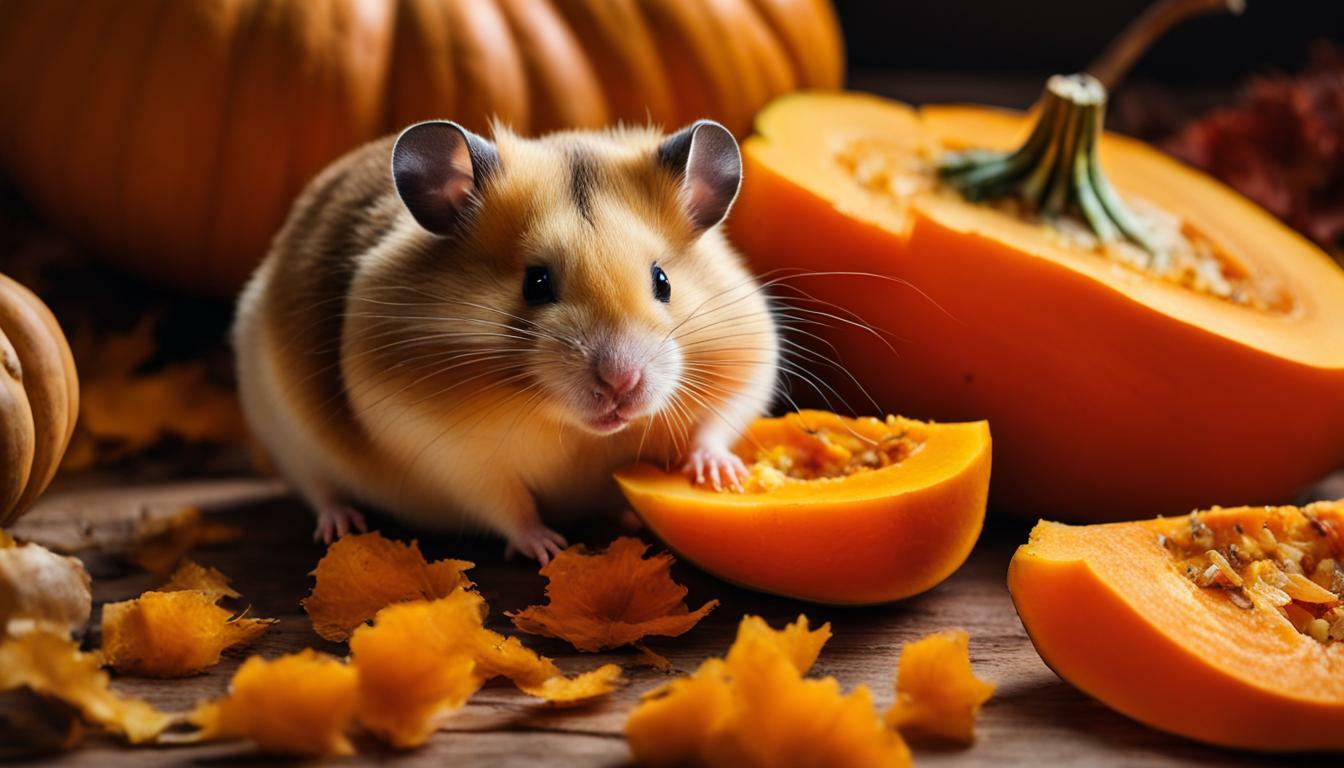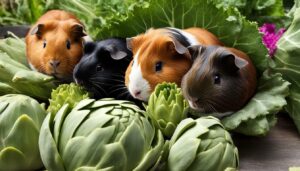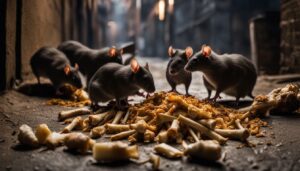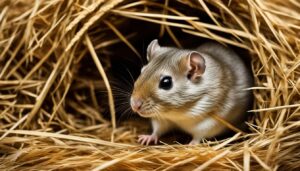If you’re wondering whether it’s safe to feed your hamster squash, we’ve got all the answers for you. Hamsters can eat squash in moderation, as it is high in nutrients and contains vitamins C, B6, and A, as well as iron, calcium, and magnesium. However, due to its low vitamin C content, squash should only be given to hamsters in small amounts. Whether you prefer to feed your furry friend raw, cooked, or canned squash, we’ll provide you with all the information you need to ensure your hamster’s diet is safe and nutritious.
Key Takeaways:
- Hamsters can eat squash in moderation, as it is high in nutrients.
- Squash contains essential vitamins and minerals like vitamin C, B6, and A, and iron, calcium, and magnesium.
- It’s important to feed hamsters squash in small amounts due to its low vitamin C content.
- Raw squash is the best option for feeding hamsters, as cooking can decrease its nutrient content.
- Before feeding cooked or canned squash to your hamster, make sure to remove any added salt, sugar, or spices.
Understanding Hamster Diets
Before we dive into whether hamsters can eat squash, let’s talk about the importance of a proper hamster diet. Just like any other pet, hamsters require a balanced and nutritious diet to thrive and stay healthy. Providing them with the right foods is essential for their well-being.
Hamsters are omnivores, which means they can eat a variety of foods, including fruits, vegetables, grains, and protein. A well-rounded diet ensures that they receive the necessary nutrients, vitamins, and minerals to support their growth, immune system, and overall health.
When it comes to hamster nutrition, it’s important to offer a wide range of safe foods to meet their dietary needs. This includes fresh fruits and vegetables, such as carrots, broccoli, apples, and leafy greens. These food options provide essential vitamins and fiber that contribute to their digestive health.
What to Include in a Hamster Diet
To ensure a healthy hamster diet, it’s crucial to include a mix of the following:
- High-quality hamster pellets
- Fresh fruits and vegetables
- Small amounts of protein-rich foods like cooked meats or boiled eggs
- Whole grains and seeds as occasional treats
Avoiding Harmful Foods
While there are many safe foods for hamsters, there are also certain foods that should be avoided. Some examples include chocolate, caffeine, onions, and garlic. These foods can be toxic to hamsters and may cause serious health issues.
It’s essential to research and consult a veterinarian to ensure you’re providing a proper diet for your hamster. They can provide personalized recommendations based on your hamster’s specific needs, age, and health condition.
The Nutritional Value of Squash for Hamsters
Squash offers a range of nutritional benefits for your hamster, making it a potentially healthy addition to their diet. This versatile vegetable is packed with essential vitamins and minerals, including vitamin C, B6, and A, as well as iron, calcium, and magnesium. These nutrients contribute to your hamster’s overall health and well-being, supporting their immune system, bone health, and energy levels.
When feeding your hamster squash, it’s important to do so in moderation. While squash is nutritious, it contains a relatively low amount of vitamin C. Hamsters require this vitamin in their diet to prevent health issues such as scurvy. Therefore, it’s essential to offer squash as a treat rather than a staple food. By providing variety in their diet, you can ensure your hamster receives a balanced intake of all necessary nutrients.
There are different ways to prepare and serve squash to your furry friend. Raw squash is the ideal option as cooking can lead to a loss of nutrients. Simply wash the squash, remove the skin, and cut it into small, bite-sized pieces. This allows your hamster to enjoy the natural flavors and textures of the vegetable. However, if you choose to cook the squash, be sure to avoid adding any salt, sugar, or spices, as these can be harmful to your hamster’s health.
| Raw Squash | Cooked Squash | Canned Squash |
|---|---|---|
| Benefits: maximum nutritional value | Benefits: softer texture | Benefits: convenient option |
| Preparation: wash, remove skin, and cut into small pieces | Preparation: avoid adding salt, sugar, or spices | Preparation: check for any added salt or preservatives |
If you’re considering offering yellow squash to your hamster, it’s important to remember that moderation is key. While yellow squash is a nutritious option, excessive consumption can lead to digestive issues such as diarrhea. Additionally, it’s crucial to remove the seeds from yellow squash before feeding it to your hamster, as they can pose a choking hazard.
If your hamster shows little interest in yellow squash or you’re looking to provide variety in their diet, there are several other fruits and vegetables you can offer as alternatives. Safe options include carrots, broccoli, cucumber, and apple slices. Remember to introduce new foods gradually to monitor your hamster’s response and ensure their digestive system adjusts well.
Moderation is Key
While squash can be a healthy addition to your hamster’s diet, it’s important to offer it in moderation. Squash is packed with nutrients and provides hamsters with essential vitamins and minerals, such as vitamin C, B6, and A, as well as iron, calcium, and magnesium. However, due to its low vitamin C content, it should only be given in small amounts to prevent any potential health issues.
When feeding squash to your hamster, it’s best to opt for raw squash whenever possible. Cooking squash can lead to a loss of nutrients, so raw squash retains its nutritional value and ensures that your furry friend gets the maximum benefit. If you do decide to cook or give canned squash, make sure to remove any added salt, sugar, or spices before offering it to your hamster.
Yellow squash is a popular variety that hamsters can enjoy. It’s important to introduce yellow squash gradually into their diet and offer it in small quantities. This will help prevent digestive issues such as diarrhea. Additionally, be sure to remove the seeds from the yellow squash as they can pose a choking hazard to hamsters.
If your hamster doesn’t seem to enjoy yellow squash, there are other fruits and vegetables that you can offer as alternatives. Variety is key in a hamster’s diet, so feel free to experiment with different options to keep their meals interesting and nutritious. Just remember to research each fruit or vegetable beforehand to ensure it’s safe for hamsters to consume.
| Benefits of Feeding Squash to Hamsters |
|---|
| Squash is high in vitamins C, B6, and A, as well as iron, calcium, and magnesium. |
| Feeding squash in moderation can provide hamsters with variety in their diet. |
| Raw squash is the best option for preserving the nutritional value of the vegetable. |
| Yellow squash, when given in small amounts, can be a nutritious addition to a hamster’s diet. |
Remember, always consult with a veterinarian for personalized advice on your hamster’s diet. They can provide guidance based on your hamster’s specific needs and help ensure a healthy and balanced diet for your furry friend.
Different Ways to Feed Squash to Hamsters
There are various ways to offer squash to your hamster, but it’s important to choose the right method. Squash can be fed to hamsters raw, cooked, or canned, but raw squash is the best option as cooking can lead to a loss of nutrients. Before feeding your hamster cooked or canned squash, be sure to remove any added salt, sugar, or spices, as these can be harmful to their delicate digestive system.
If you choose to feed your hamster raw squash, you’ll want to prepare it properly to ensure their safety. Start by washing the squash thoroughly to remove any dirt or pesticides. Then, slice the squash into small, bite-sized pieces that are easy for your hamster to chew and digest. Remember to remove the seeds from yellow squash, as they can be a choking hazard for your furry friend.
When introducing squash to your hamster’s diet for the first time, it’s important to do so gradually. Start by offering a small piece of raw squash and monitor your hamster’s reaction. If they tolerate it well and show no signs of digestive upset, you can gradually increase the amount over time. However, if your hamster shows any signs of diarrhea or discomfort, stop feeding them squash and consult with a veterinarian.
| Feeding Methods | Advantages | Disadvantages |
|---|---|---|
| Raw Squash | – High nutrient content – Easy to prepare – Best option for preserving nutrients |
– Seeds can be a choking hazard – Requires careful portion control |
| Cooked Squash | – Softer texture for older hamsters – May be more palatable for picky eaters |
– Nutrient loss due to cooking – Added ingredients like salt, sugar, or spices may be harmful |
| Canned Squash | – Convenient option – Soft texture for older hamsters |
– High risk of added salt, sugar, or preservatives – Nutrient loss due to processing |
While squash can be a nutritious addition to your hamster’s diet, it’s important to offer it in moderation. Hamsters should only have small amounts of squash due to its low vitamin C content. Remember to always provide a balanced diet for your hamster, offering a variety of safe fruits and vegetables alongside their regular hamster food. If your hamster doesn’t seem to enjoy yellow squash, there are plenty of other options to try, such as spinach, carrots, or apples. Consult with a veterinarian to ensure that your hamster’s diet meets their specific nutritional needs.
Yellow Squash for Hamsters
Yellow squash can be a nutritious option for your hamster, but there are some things to keep in mind. This variety of squash is packed with vitamins and minerals that contribute to your furry friend’s overall well-being. Vitamin C, B6, and A are found in abundance in yellow squash, providing essential nutrients for your hamster’s immune system and eye health. Additionally, yellow squash contains iron, calcium, and magnesium, which play a vital role in maintaining strong bones and teeth.
To incorporate yellow squash into your hamster’s diet, it’s important to introduce it gradually and in small amounts. While this squash is nutritious, feeding it in excess can lead to digestive issues, such as diarrhea. Remove the seeds from the yellow squash before feeding it to your hamster, as they can pose a choking hazard. Remember, moderation is key when offering any new food to your hamster.
| Benefits of Yellow Squash for Hamsters | Precautions and Considerations |
|---|---|
|
|
If your hamster isn’t a fan of yellow squash, fret not! There are plenty of alternative fruits and vegetables that can be offered to provide variety in their diet. Some safe options include carrots, broccoli, apples, and strawberries. Remember to always research and consult reliable sources to ensure you’re offering the best food choices for your furry friend.
Alternatives to Yellow Squash
If your hamster isn’t a fan of yellow squash, don’t worry, there are plenty of other options available. Hamsters have a wide range of safe fruits and vegetables that can be included in their diet to provide variety and additional nutrients. Here are some great alternatives to yellow squash:
- Carrots: Carrots are a popular choice for hamsters and are packed with vitamins and minerals. They are crunchy and delicious, making them a great snack for your furry friend.
- Broccoli: Broccoli is another nutritious option for hamsters. It is high in fiber and contains vitamins C and K, as well as other essential nutrients. Just make sure to offer it in small, bite-sized pieces.
- Apples: Apples are a sweet treat that many hamsters enjoy. They are a good source of vitamin C and fiber. Remember to remove the seeds and core before giving them to your hamster.
- Cucumbers: Cucumbers are hydrating and refreshing for hamsters. They are low in calories and a good source of vitamin K. Slice them into thin pieces to make it easier for your hamster to eat.
Remember, when introducing new fruits and vegetables to your hamster, do so gradually and in small amounts. This will help prevent digestive issues and allow you to monitor if your hamster has any negative reactions. Offering a variety of fruits and vegetables will keep your hamster’s diet interesting and ensure they receive a wide range of nutrients.
| Fruits | Vegetables |
|---|---|
| Apples | Carrots |
| Bananas | Broccoli |
| Grapes | Cucumbers |
| Strawberries | Peas |
“A balanced diet for your hamster is key to keeping them healthy and happy!”
Offering a variety of fruits and vegetables not only provides necessary nutrients, but it also allows your hamster to experience different flavors and textures. It’s important to remember that the key to a healthy hamster diet is moderation. While fruits and vegetables are a great addition to their meals, they should never be the sole source of nutrition. Hamsters also need a balanced diet with a quality hamster food that is appropriate for their specific breed.
Potential Risks and Considerations
While squash can be a healthy treat for hamsters, it’s essential to be aware of potential risks and take appropriate precautions. Feeding your hamster too much squash can lead to diarrhea, as it is high in water content. To prevent digestive issues, it’s important to offer squash to your hamster in moderation.
As with any new food, it’s recommended to introduce squash gradually into your hamster’s diet. Start by offering a small piece and observe your hamster’s reaction. If there are no adverse effects, you can gradually increase the amount over time. However, if you notice any signs of digestive upset or changes in their stool, it’s best to reduce or eliminate squash from their diet.
Another important consideration when feeding squash to hamsters is the removal of any added salt, sugar, or spices. These additives can be harmful to your hamster’s health. When offering cooked or canned squash, make sure to check the labels for any unwanted ingredients and ensure that the squash is plain and unseasoned.
| Tips | Details |
|---|---|
| Feed raw squash | Raw squash is the best option to ensure your hamster receives the maximum nutritional benefits. Cooking can degrade the vitamins and minerals present in squash. |
| Remove seeds | When feeding yellow squash, be sure to remove the seeds as they can pose a choking hazard. |
| Feed in small amounts | Offer squash as a small treat rather than a significant portion of your hamster’s diet. This helps prevent an imbalance in their overall nutrition. |
If your hamster doesn’t seem to enjoy or tolerate squash, don’t worry. There are plenty of other safe fruits and vegetables that you can offer as an alternative or supplement to their diet. Some suitable options include carrots, broccoli, apples, and strawberries. Remember, variety is key to providing a balanced and nutritious diet for your furry friend.
Always consult with a veterinarian for personalized advice on your hamster’s diet. They can provide guidance based on your hamster’s individual needs and help you ensure they are receiving all the necessary nutrients for their overall health and well-being.
Conclusion
In conclusion, while hamsters can enjoy squash, it should be offered in moderation as part of a balanced diet. Squash is a nutritious treat for hamsters, containing important vitamins and minerals such as vitamin C, B6, and A, as well as iron, calcium, and magnesium. However, due to its low vitamin C content, it should only be given in small amounts to prevent health issues.
When feeding squash to hamsters, it is best to offer it raw to ensure maximum nutrient intake. Cooking squash can cause a loss of nutrients, so it’s important to feed it in its natural state. If you choose to cook or use canned squash, make sure to remove any added salt, sugar, or spices before serving it to your furry friend.
Yellow squash is a popular variety for hamsters, but it should also be given in moderation. Although it is nutritious, feeding too much yellow squash can lead to diarrhea. It’s also important to remove the seeds from yellow squash as they can present a choking hazard for hamsters. If your hamster doesn’t enjoy yellow squash, there are plenty of other fruits and vegetables that can be offered as alternatives to keep their diet varied and balanced.
Remember, each hamster is unique, so it’s always a good idea to consult with a veterinarian for personalized advice on your hamster’s diet. By providing a well-rounded and diverse diet, you can ensure that your hamster stays happy, healthy, and satisfied.
Reference Sources
For further reading and detailed information about hamster diets and the safety of feeding them squash, consult the following references:
- Hamster Nutrition Guide – A comprehensive website dedicated to providing accurate and up-to-date information on hamster diets, including safe foods, nutritional requirements, and feeding tips.
- PetMD – An online resource that offers a wealth of information on pet health and nutrition. Their articles on hamster care cover various aspects, including diet and feeding guidelines.
- The Spruce Pets – This website provides expert advice and practical tips for pet owners. They have well-researched articles on hamster care, including information on their diets and safe food options.
Quotes from Experts:
“A balanced and nutritious diet is crucial for the overall health and well-being of hamsters. Squash can be a healthy treat for them, but it should be given in moderation to avoid any potential digestive issues.” – Dr. Jane Wilson, DVM
Important Considerations:
- Always introduce new foods, including squash, gradually to your hamster’s diet to ensure they tolerate it well.
- Monitor your hamster for any signs of discomfort or digestive problems after feeding them squash. If any issues arise, it’s best to consult a veterinarian.
- Remember that variety is key in a hamster’s diet. While squash can be a nutritious addition, it should not replace other essential foods in their diet.
Summary:
Squash can be a healthy and nutritious addition to a hamster’s diet. It contains vital vitamins and minerals that contribute to their overall well-being. However, it’s important to feed squash in moderation due to its low vitamin C content. Raw squash is the preferred option as cooking can reduce its nutrient value. Remove any added salt, sugar, or spices from cooked or canned squash before offering it to your hamster. Yellow squash is a good choice, but remember to provide it in small amounts and remove the seeds to prevent choking hazards. If your hamster dislikes squash, there are other safe fruits and vegetables you can offer as an alternative. Consult reputable sources for more detailed information on hamster diets and the safety of feeding them squash.
| Reference Source | Website |
|---|---|
| Hamster Nutrition Guide | www.hamsternutrition.com |
| PetMD | www.petmd.com |
| The Spruce Pets | www.thesprucepets.com |
Further Resources
If you’re interested in delving deeper into hamster diets and finding more resources for feeding your furry friend, consider checking out the following recommendations.
1. Hamster Diet Guide: This comprehensive website offers a wealth of information on hamster diets, including safe foods, nutritional requirements, and tips for feeding hamsters. It’s a great resource for understanding the dietary needs of your hamster and ensuring they receive a balanced diet.
2. Feeding Hamsters 101: This book is written by an expert in hamster care and provides valuable insights into feeding hamsters. It covers topics such as portion sizes, food hygiene, and the importance of variety in a hamster’s diet. It’s a must-read for any hamster owner looking to enhance their pet’s nutritional well-being.
3. Hamster Owners Forum: Joining an online community of fellow hamster owners can be a valuable resource for finding advice, tips, and support. This forum is dedicated to hamster care and offers a wealth of knowledge from experienced hamster owners. You can connect with others, share your experiences, and learn from their insights.
Remember, always consult with a veterinarian for personalized advice on your hamster’s diet. They can provide guidance tailored to your pet’s specific needs and ensure their overall health and well-being. Happy feeding!
FAQ
Can hamsters eat squash?
Yes, hamsters can eat squash in moderation.
What nutrients does squash contain?
Squash is high in vitamins C, B6, and A, as well as iron, calcium, and magnesium.
How much squash should I feed my hamster?
Hamsters should only be given small amounts of squash due to its low vitamin C content.
Can hamsters eat raw, cooked, or canned squash?
Yes, hamsters can eat squash in any of these forms. However, it’s best to feed them raw squash to ensure they get the maximum nutrients.
Should I remove any added salt, sugar, or spices from cooked or canned squash?
Yes, it’s important to remove any added salt, sugar, or spices from cooked or canned squash before feeding it to hamsters.
Can hamsters eat yellow squash?
Yes, yellow squash is a nutritious addition to a hamster’s diet. However, it should be given in small amounts to avoid diarrhea, and the seeds should be removed to prevent choking hazards.
What if my hamster doesn’t like yellow squash?
If a hamster doesn’t like yellow squash, there are other fruits and vegetables that can be offered as an alternative.




